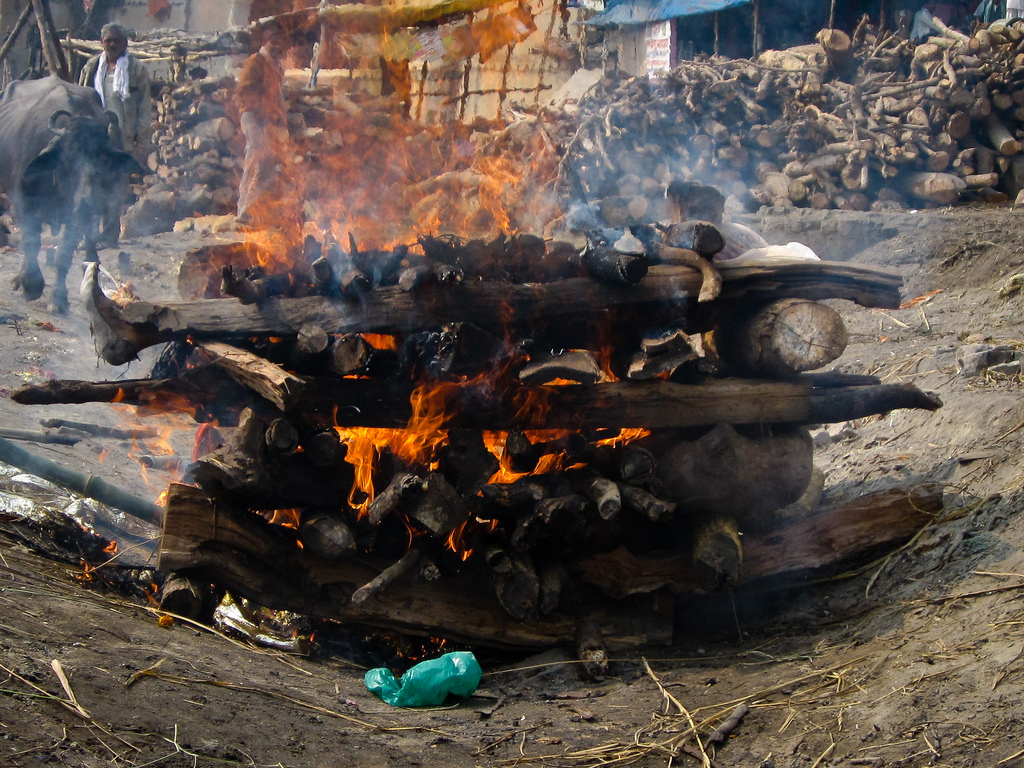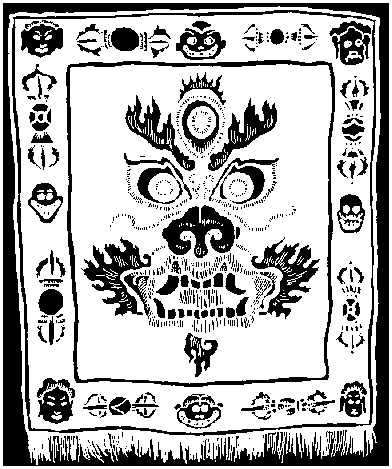
Helena Petrovna Blavatsky and
The Burning Ghats
India, 1900

In the vicinity of these cemeteries rise the Hindu ghâts. There is really something grand in this ritual of burning the dead --- and the burning of the living in the not too distant past, but only in theory and not in practice. Witnessing this ceremony, and seeing how in the course of an hour or so after death nothing remains of the body but a few handfuls of ashes which an initiated Brâthmana, performing the rites of death, scatters then and there to the four winds of heaven over the river, so that they will be forever mingled with the sacred waters, the spectator is struck with the deep philosophy underlying the fundamental idea of this rite.In scattering the handful of that which once lived and felt, loved and hated, rejoiced and wept, the Brâthmana entrusts the ashes to the four elements:
- Earth, out of which it grew and developed little by little into a man, and which fed it for a long time;
- Fire, emblem of purity, that has just devoured the body, so that the spirit will be equally purified from all that is sinful, and may freely gravitate to the new sphere of postmortem existence where every sin is a stumbling block on the way to "Moksha" or eternal bliss;
- Air, which was inhaled and thus sustained life; and
- Water, which cleansed it physically and spiritually, quenched its thirst, and now receives its ashes into her pure bosom.
The adjective "pure" must be understood here merely in the figurative sense of the "mantra." Generally speaking, the rivers in India, beginning with the thrice sacred Ganges, are unimaginably dirty, especially near villages and towns. Some two hundred million people, in round numbers, cleanse themselves therein from tropical sweat and dirt several times a day; and, moreover, castes whose members are not worthy of being burned, such as sûdras, pariahs, mângs. etc., throw all their corpses into them. Furthermore, all castes, including Brâhmanas, throw children who die at less than three years of age into the rivers.
Let us wander along the shores of any river, but rather late in the evening, so as to spend the night there until daybreak. Only the rich, or those belonging to the highest castes are burned in the evening. Only for them are lit after sunset sandalwood fires beside the sacred waters; for them alone, mantras and incantations to the Gods are chanted. For ordinary mortals, for the poor outcastes, there is neither fire nor even an ordinary prayer.
A sûdra is unworthy of listening even after death to the divine words from the sacred book of revelation, dictated at the beginning of the world by the four Rishis to Veda-Vyâsa, the great theologian of Aryavârta. As he was not allowed during his lifetime nearer than seven steps from the temple, so even in the afterlife a sûdra will not be permitted to stand beside the "twice-born."
Brightly burn the fires, extending like a fiery serpent along the river. Dark silhouettes of strange, wildly fantastic figures silently move among them, either raising their thin arms toward the sky as if in prayer, or adding fuel to the fires and poking them with long iron pitchforks, until the dying flames flare up again, creeping and twisting, spattering in all directions melted human fat, and shooting upwards whole showers of golden sparks, which instantly vanish in the thick cloud of black smoke. This is on the right side of the river. Let us cross over to the left bank.
In the hours before dawn when the red fires, the black clouds of miasma, and the thin figures of the fakir-servants grow dim and slowly vanish after a last reflection in the dark mirror of the river; when the smell of burned flesh is blown away by the fresh wind which rises at the approach of dawn, and quiet settles over the ghâts until the next evening --- at that instant a procession of a different kind appears on the opposite bank. Sad, silent trains of Hindu men and women move in file, sometimes long, sometimes short, according to the mortality in town. They approach the river in separate groups, without weeping, and with no ritual of any kind. Swinging their burden by both head and feet, the carriers cold-bloodedly throw it into the yellowish-dirty water of the river. As it falls, the red rag is blown aside, and the dark green face of a young woman can be seen for an instant before vanishing in the muddy waves.

Beyond is another group: an old man and two young women. One of them, a little girl of ten, small, thin, far from being fully developed, sobs bitterly. She is the mother of the dead child, whose body she will soon throw into the cold waters of the dirty river. Her weak voice monotonously resounds along the shore, and her trembling hands are not strong enough to throw the poor little figure, more like a tiny brown kitten than a human child.
The old man tries to console her and, taking the dead body in his own hands, enters the water up to his waist, casting it into the middle of the river. After him both women get into the water just as they are, dressed or rather half-dressed, as usual, and after plunging seven times in succession to purify themselves from the touch of a dead body, return to the shore and start for home, their clothes dripping wet. In the meanwhile, vultures, crows and other birds of prey, which had been circling all day over the river waiting for their booty, gather in black clouds over the bodies and retard their progress down the river.
Occasionally some half-stripped skeleton is caught in the reeds along the shore or is wedged between two stones, sticking out from the shallow water, until finally one of the mângs --- a wretched out-caste creature, living near the river, whose fate it is all life-long, from the day of his birth to his last breath, to busy himself with this sort of unclean labor --- comes armed with his long stick and, catching the skeleton by its ribs, picks it from under the stones or reeds and pushes it down the current on its way to the blue ocean.
--- From the Caves and Jungles of Hindostan.